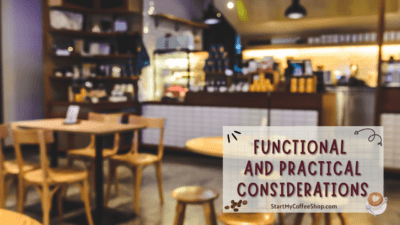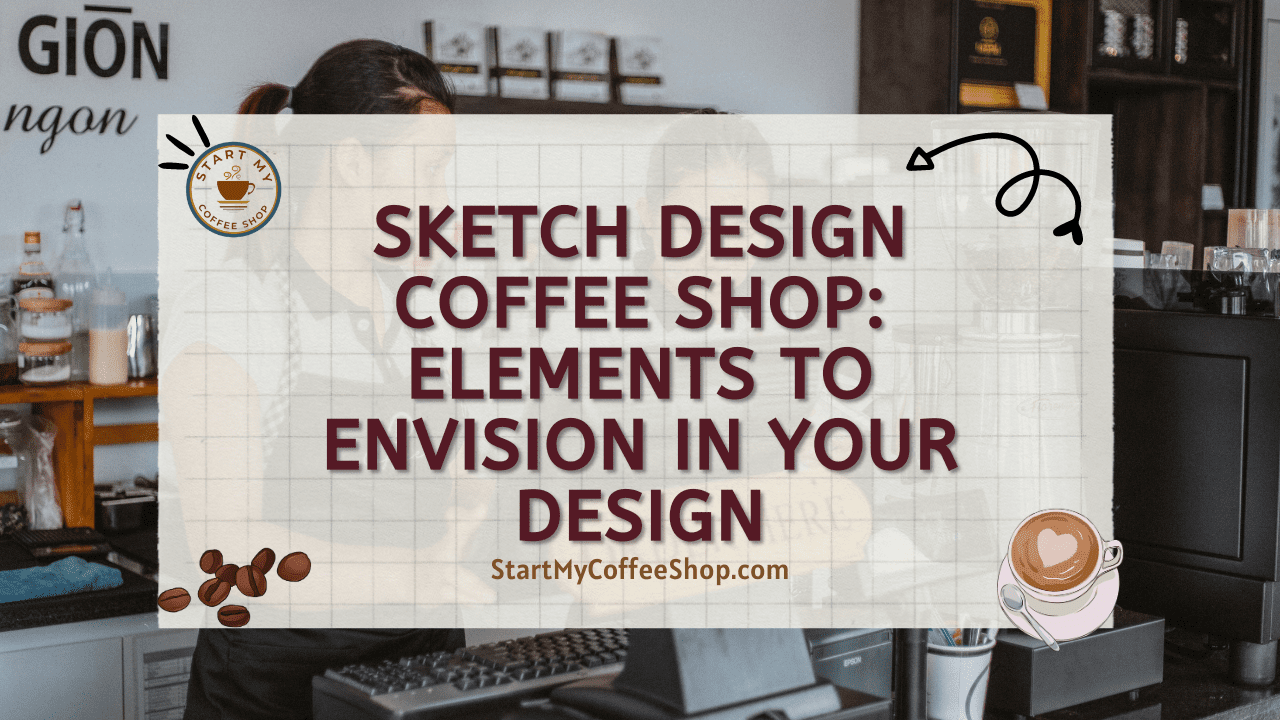Designing a coffee shop is not just about serving great coffee; it’s about creating an inviting and immersive experience for customers. A well-thought-out sketch design can set the stage for a cozy ambiance, promote social interaction, and enhance the overall enjoyment of the coffee shop.
Ideal coffee shop design includes an open and inviting layout, cozy seating areas, natural light, trendy decor, a central coffee bar, ample power outlets, free Wi-Fi, a soothing color scheme, eco-friendly materials, a functional kitchen, a comfortable restroom, and outdoor seating (if applicable).
In this article, I will explore the key elements and features that form the foundation of an ideal coffee shop design.
1. Layout and Spatial Planning
The layout of a coffee shop is a critical element that can significantly influence the overall customer experience. It sets the stage for how patrons interact with the space and ultimately shapes their perception of the establishment. An open and inviting layout is key to creating a welcoming atmosphere that encourages exploration and social interaction.
To cater to various preferences, consider incorporating a combination of communal tables, cozy nooks, and individual seating options throughout the coffee shop. Communal tables provide an opportunity for customers to connect and engage with others, fostering a sense of community.
Cozy nooks, on the other hand, offer intimate spaces for those seeking solitude or private conversations. Individual seating options, such as comfortable chairs or booths, provide flexibility and cater to customers who prefer a more personal experience.
A central coffee bar can serve as a focal point within the layout. Positioning the coffee bar strategically allows customers to observe the brewing process and interact with the baristas, adding an element of theater and enhancing the overall experience. The baristas become not just coffee makers but also performers, showcasing their craft and creating a sense of connection between the customers and the coffee-making process.
Another crucial aspect to consider is the flow of movement within the space. Customers should be able to navigate the coffee shop effortlessly, with clear pathways that guide them from the entrance to the counter, seating areas, restrooms, and any outdoor spaces. Smooth traffic flow minimizes congestion and ensures a seamless experience for customers, allowing them to easily access the various areas of the coffee shop.
By carefully considering the layout and flow of movement, you can create a coffee shop design that maximizes customer satisfaction. The layout should encourage exploration, social interaction, and a smooth flow of operations.
Whether customers are looking for a cozy nook to enjoy a book, a communal table to meet new people, or a comfortable spot at the coffee bar to witness the brewing process, the layout should cater to their preferences and enhance their overall experience. Remember, the goal is to create a space where customers feel welcomed, comfortable, and inspired to linger and enjoy their favorite cup of coffee.
2. Atmosphere and Decor
Creating the right atmosphere through decor is a vital aspect of coffee shop design. The decor sets the tone and establishes the desired ambiance that resonates with your brand and target customers. A well-executed decor can leave a lasting impression and elevate the overall customer experience.
One essential consideration is the color scheme. Opt for a soothing palette that complements the desired atmosphere of your coffee shop. Warm neutrals, such as soft browns, creamy whites, or gentle grays, can create a cozy and inviting environment. Calming pastel shades, like muted blues or pale greens, can evoke a sense of tranquility. These colors promote relaxation and help customers unwind while enjoying their favorite coffee blends.
Thoughtfully selected artwork, strategically placed around the coffee shop, can add character and visual interest. Consider featuring local artists or coffee-related artwork that aligns with your brand. It can spark conversations among customers and provide a unique focal point within the space. Wall accents, such as decorative shelves displaying coffee-related items or framed quotes about coffee, can add a touch of personality and create a cozy ambiance.
Integrating natural elements into the decor can further enhance the coffee shop’s atmosphere. Incorporate wood elements in furniture, flooring, or wall paneling to create a warm and organic feel. Stone accents, such as a feature wall or countertops, can add a touch of elegance and sophistication. These natural materials connect customers with the earthy origins of coffee, fostering a sense of authenticity and warmth.
Lighting is a crucial element in setting the mood of the coffee shop. Maximize the use of natural light during the day by incorporating large windows or skylights. Natural light not only creates an inviting and airy atmosphere but also allows customers to appreciate the surroundings. In the evenings, opt for warm and soft lighting to create a cozy ambiance. Use a combination of ambient, task, and accent lighting to highlight specific areas or create a sense of depth and intimacy.
3. Functional and Practical Considerations
In addition to visual appeal, functionality is a key aspect of a well-designed coffee shop. It involves ensuring that the space is efficient, practical, and equipped to handle the demands of daily operations. Several practical considerations contribute to a seamless and enjoyable experience for both staff and customers.

First and foremost, the kitchen area should be designed to facilitate smooth and efficient beverage and food preparation. It should be equipped with high-quality equipment and ample counter space for baristas to work comfortably. The layout should prioritize workflow, ensuring that ingredients, utensils, and equipment are easily accessible. A well-organized kitchen allows baristas to deliver beverages and food promptly, maintaining a high level of customer satisfaction.
Adequate storage space is essential for keeping ingredients, utensils, and equipment organized and readily available. A well-designed storage system helps streamline operations and prevents clutter. It is crucial to allocate dedicated storage areas for perishable and non-perishable items, as well as for cleaning supplies and other essential tools. Efficient storage reduces time spent searching for items, allowing staff to focus on serving customers efficiently.
Restroom facilities should not be overlooked when it comes to functionality. They should be clean, well-maintained, and easily accessible to customers. Adequate ventilation, proper lighting, and comfortable amenities contribute to a positive restroom experience. Attention to detail, such as providing hand dryers or high-quality paper towels, enhances overall customer satisfaction and reflects the commitment to a pleasant environment.
To cater to the needs of customers, it is essential to provide convenient amenities such as power outlets and free Wi-Fi. Power outlets near seating areas allow customers to charge their devices while enjoying their coffee, catering to those who work or study in the coffee shop. Offering free Wi-Fi creates an environment where customers can connect online, whether it be for work, socializing, or browsing the internet. These amenities enhance the overall customer experience and encourage them to spend more time in the coffee shop.
Read more about Running a Coffee Shop Costs: A Deep Dive into Financial Considerations
4. Comfortable Seating
Seating arrangements in a coffee shop are pivotal in creating a comfortable and inviting environment that caters to the diverse needs of customers. By considering a variety of seating options, you can accommodate different preferences and enhance the overall experience.
Communal tables are a popular choice as they encourage group interactions and foster a sense of community within the coffee shop. These tables provide opportunities for customers to engage in conversations, share experiences, or even make new connections. The communal setting promotes a social atmosphere that can be particularly appealing to individuals seeking a vibrant and interactive environment.
For customers seeking more privacy or intimate conversations, cozy booths are an excellent option. These secluded seating areas provide a sense of seclusion and allow individuals or small groups to enjoy their coffee in a more secluded space. The booth setup creates a cozy and intimate ambiance that lends itself well to conversations or focused work.
Individual seating options are essential to cater to customers who prefer solitude or who simply enjoy their own company. Comfortable chairs and sofas with plush cushions or ergonomic designs provide a relaxing and cozy environment for customers to unwind and enjoy their coffee at their own pace. These individual seating areas can be strategically placed to offer customers a sense of personal space and freedom.
When designing seating arrangements, it’s crucial to strike a balance between privacy and sociability. Providing a mix of communal, booth, and individual seating ensures that customers can choose an option that aligns with their desired level of interaction.
Additionally, consider the arrangement of seating areas to create a natural flow and maintain a comfortable distance between tables. This allows customers to enjoy their coffee without feeling overcrowded or intrusive.
Comfort is paramount in seating arrangements. Ergonomic design, quality materials, and ample cushioning are key factors to consider when selecting chairs and sofas. Comfortable seating encourages customers to stay longer, relax, and fully savor their coffee shop experience.
5. Outdoor Spaces
If space allows, incorporating outdoor seating areas can be a fantastic addition to a coffee shop, providing patrons with an opportunity to enjoy their beverages in the fresh air and embrace the ambiance of their surroundings. Outdoor seating creates a delightful extension of the coffee shop experience, allowing customers to people-watch, enjoy the weather, and engage with their community.
When designing outdoor seating areas, it is essential to select furniture that is weather-resistant, durable, and comfortable. Opt for materials that can withstand various weather conditions, such as metal, teak, or synthetic wicker, ensuring that they remain in good condition and retain their aesthetic appeal over time.
Comfortable cushions or padded seats can enhance the overall experience, enticing customers to spend more time enjoying their coffee and the outdoor atmosphere.
To create an inviting outdoor atmosphere, incorporate greenery into the design. Potted plants, hanging baskets, or vertical gardens can bring a touch of nature to the outdoor seating area, adding freshness and vibrancy. Plants not only provide aesthetic value but also contribute to a sense of tranquility and relaxation.
Shade options are crucial to ensure customers’ comfort during sunny or rainy days. Install umbrellas or consider adding pergolas with retractable awnings to protect from direct sunlight. This way, customers can enjoy their coffee without being exposed to harsh rays or light rain showers. Creating a comfortable and shaded environment enhances the overall experience and encourages customers to opt for outdoor seating.
Summary
Designing an ideal sketch for a coffee shop requires careful consideration of several key elements. A well-planned layout, inviting atmosphere, practical amenities, and comfortable seating are all integral to creating a memorable customer experience.
Balancing functionality and aesthetics is key, ensuring smooth operations while enchanting customers with a visually appealing ambiance. The coffee shop design should align with the intended brand image and target audience, fostering a sense of community and providing a space for people to relax, work, or connect.
So, let your creativity flow, and design the coffee shop of your dreams—one sip at a time!
Frequently Asked Questions

1. What considerations should I keep in mind when designing the layout of a coffee shop?
When designing the layout of a coffee shop, it’s important to consider factors such as customer flow, accessibility to various areas, seating options for different preferences, and the placement of the coffee bar as a focal point.
2. How can I create a cozy and inviting atmosphere in my coffee shop?
Focus on elements such as warm lighting, comfortable seating arrangements with plush cushions, soothing color schemes, and the use of natural materials like wood or stone.
3. What are some practical considerations when designing a coffee shop?
It includes having a well-equipped kitchen area for efficient operations, sufficient storage space for ingredients and equipment, convenient amenities like power outlets and free Wi-Fi for customers, and comfortable and accessible restroom facilities.
Read more about
To learn more on how to start your own coffee shop checkout my startup documents here
Please note: This blog post is for educational purposes only and does not constitute legal advice. Please consult a legal expert to address your specific needs.

Hi! I’m Shawn Chun
My adventure in coffee began when I first launched my first coffee shop back in the early 2000s. I had to figure out so many things on my own and to make it worse within 2 years of opening two large corporate coffee chains moved in just blocks away from me!
As I saw smaller and even some larger coffee shops in the neighborhood slowly lose customers to these giant coffee chains and slowly close up shop, I knew that I had to start getting creative…or go out of business.
I (like you may be) knew the coffee industry well. I could make the best latte art around and the foam on my caps was the fluffiest you have ever seen. I even had the best state-of-the-art 2 group digital Nuova Simonelli machine money could buy. But I knew that these things alone would not be enough to lure customers away from the name brand established coffee shops.
Eventually, through lots of trial and error as well as perseverance and creativity I did find a way to not only survive but also thrive in the coffee/espresso industry even while those corporate coffee chains stayed put. During those years I learned to adapt and always faced new challenges. It was not always easy, however, in the end, I was the sole survivor independent coffee shop within a 10-mile radius of my location. Just two corporate coffee chains and I were left after that year. All told the corporate coffee chains took down over 15 small independent coffee shops and kiosks and I was the last one standing and thriving.
Along the years I meet others with the same passion for coffee and I quickly learned that it is not only “how good a barista is” that makes a coffee shop successful, but the business side of coffee as well.
Hence why I started this website you are on now. To provide the tools and resources for up and coming coffee shop owners to gain that vital insight and knowledge on how to start a coffee shop successfully.
Stick around, browse through my helpful blog and resources and enjoy your stay! With lots of LATTE LOVE!
Shawn







